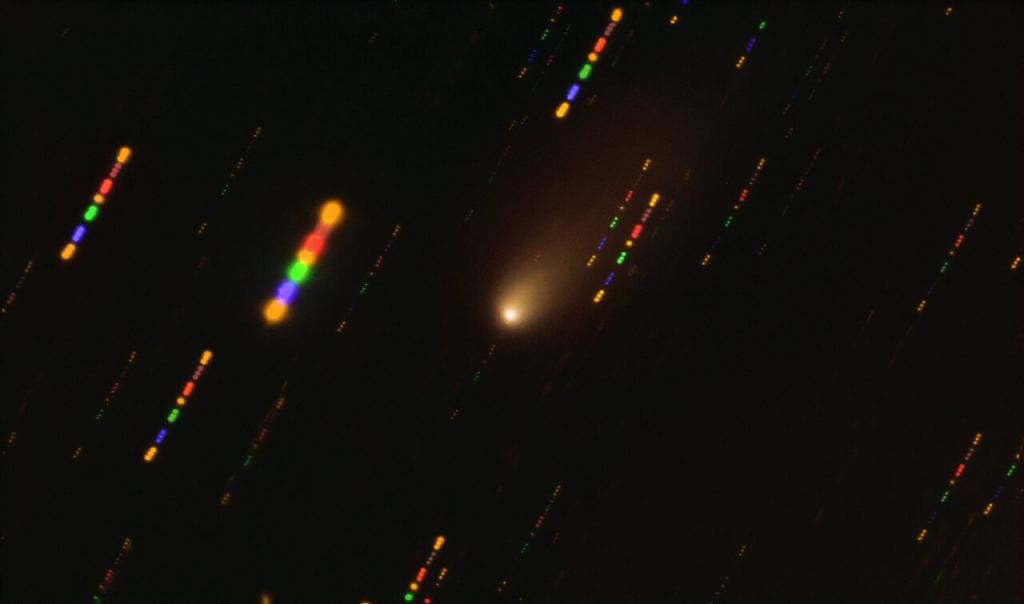In outer space, an object's location has a huge impact on its temperature. The closer the object is to its star, the hotter it most likely is. Heat then plays a major role in what materials are present in that object's atmosphere, if it has one. Lighter elements such as hydrogen and helium and much easier to take a gaseous state and create an atmosphere. So it came as a surprise when two different teams found much heavier elements in the atmosphere of comets that were relatively far away from the Sun. And one of those comets happened to be from another solar system.
Many comets are metallic, so there wasn't much surprise that elemental metals such as iron and nickel are present on their surface. And when metallic comets approach the sun those elements can sometimes sublimate into the cloud of dust that surrounds the comet. Astronomers have observed this phenomena for years, and it makes sense given the temperatures involved.
UT video explaining the origin of comets.When a team of astronomers at the University of Liège studied the atmospheres of a series of comets that were relatively far away from the solar system, they found some strange spectral lines that they couldn't explain. Using the European Southern Observatory's Very Large Telescope (VLT), they were looking at comets that were three times further from the sun than Earth is, making them cold and stable compared to comets closer in.
After some further research the team realized the spectral lines they were looking at were representative of very weak signals for iron and nickel. Strangely, the two elements were almost the same concentration, with about 1 g of iron and 1 g of nickel per 100 kg of water in the comet's atmosphere. Closer to the sun, where it is more common to find these heavier elements in comet's atmospheres, there is usually about 10 times the amount of iron than there is nickel.
This could mean there is some new material that contains iron and nickel and has a much lower sublimation temperature. Or there could be as yet unexplained reasons for the appearance of these metals. However, the team already has some steps forward, including reanalyzing other older data to check is the faint spectral lines are there too. Soon they will also have a new tool on the Extremely Large Telescope called the Mid-Infrared ELT Imager and Spectrograph (METIS) that will allow them to figure out the exact composition of the material that led to the atmospheric iron and nickel.
Unfortunately, the team studying the other object found with heavy metals in its atmosphere will not be able to use METIS to observe it. That's because the object, 2I/Borisov, is an interstellar comet that zipped through our solar system, split into two chunks, and flew out of range of our instruments, a few years ago.
The team did use a tool they had on hand at the time though - the X-shooter spectrograph as the VLT. While they didn't find any iron in Borisov's atmosphere, they did find atomic nickel. Given that the comet was 300 million kilometers away from the sun when it was observed, this is again surprising given that previous estimates would have expected the comet to be too cold to have atmospheric nickel.
While Borisov itself might be out of view, now that we know what to look for it's likely we'll find other interstellar interlopers in the near future. With better observational instruments and new theories to address why these unexpected elements are showing up in cometary atmospheres, the future is looking bright for cometary science.
Learn More:
ESO - Heavy metal vapours unexpectedly found in comets throughout our Solar System — and beyond
Nature - Iron and nickel atoms in cometary atmospheres even far from the Sun
Nature - Gaseous atomic nickel in the coma of interstellar comet 2I/Borisov
Sky and Telescope - INTERSTELLAR AND SOLAR SYSTEM COMETS SHARE A SURPRISING INGREDIENT: NICKEL
Lead Image:
Depiction of elements found in comets using the VLT.
Credit - ESO
 Universe Today
Universe Today


